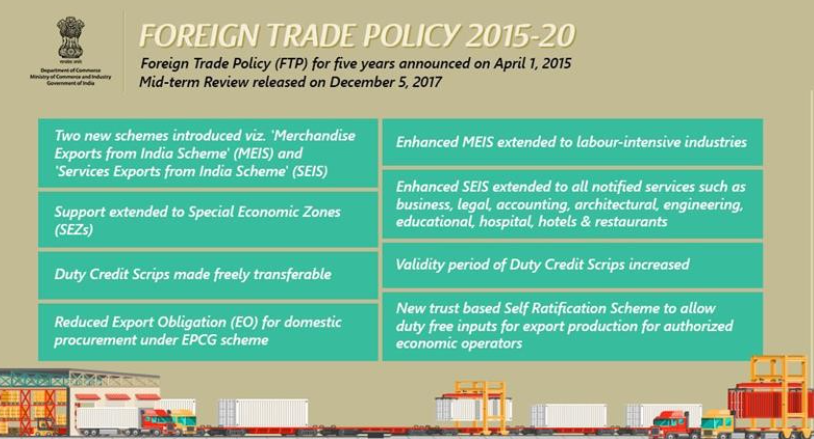- Revisited and notified quinquennially since the 1991 economic reforms, the FTP has been the guiding beacon for all stakeholders.
Why is a New Foreign Trade Policy Important?
- Clarifying India’s Stand at Global Level: It is essential to clarify India’s position and alignment with flagship programmes like ‘Local for Global’ and PLI (Production Linked Incentive) schemes,WTO’sruling againstIndia’s export incentive schemes, an overdue review of the Special Economic Zone (SEZ) scheme, changing geographical profiles of India’s export basket, and implications of the FTAs.
- In 2019, a dispute resolution panel of WTO had held that the export incentives under the FTP are violative of India’s WTO Commitment.
- The 2015 FTP incentivised exports by issuing duty-credit scrips directly in proportion to exports. However, in 2020 the government limited the maximum export incentives for goods to Rs. 20 million, and in 2021, limited them to Rs. 20 million for services.
- Moreover, the changes for service incentives were retrospectively notified in September 2021 to be applied from April 2019.
- The remaining Rs. 38,558 crore has been diverted into PLI to give benefit to a few sectors.
- Also, earlier there was a 3% export incentive on agriculture implements like tractors, which has been reduced to 0.7%.
- The rise in prices of raw materials such as steel, and plastics along with a shortage of shipping containers and labour are making it difficult for the MSMEs to take full advantage of the global increase in demand.
What can be the Possible Amendments in the New FTP?
- Solving MSMEs’ Crisis: Under the SEIS, an incentive of 3-7% of net foreign exchange earnings is provided to services exporters of notified services in India.
- A modification in the minimum cap for the net foreign exchange earnings eligible to claim under the scheme and faster GST refunds to global services are much needed with the new FTP.
- The government must also help MSMEs tap the export potential in existing tariff lines and provide policy support to raise the number of exporting MSMEs and increase MSME exports by 50% in 2022-23.
- The new FTP must enable exporters to leverage technology in the field of foreign trade. This will be particularly beneficial for MSMEs to compete with their global peers.
- India needs to invest in upgrading export infrastructure to stay ahead of technology-advanced countries such as China.
- It also needs to adopt modern trade practices that can be implemented through the digitisation of export processes. This will save both time and cost.
- Therefore, there is an urgent need to bridge the gap between the two policies. Furthermore, a seamless disbursal of GST refunds, without administrative delays, carries paramount importance.
- The Indian government is well aware of the need to stay within the WTO norms and has already taken significant steps to withdraw subsidy-led schemes.
- However, more needs to be done at a fundamental level to promote exports and ensure that Indian exports are competitive in the global market.
- These considerations should also factor the contemporary paradigm such as the impelling need for fuel-import substitution, leveraging the improvised logistic and fuelling entrepreneurial drive.
- Given the economic hardship caused by the pandemic, the new FTP shall work in a phased manner to address export constraints, review the regulatory and operational framework to reduce the transit costs and create a low-cost operating environment through developed logistics and utility infrastructure.
Drishti Mains Question
“Exports are a vital part of the country’s GDP and foreign trade must be given sufficient importance and investment. The upcoming Foreign Trade Policy should take proactive steps to ensure that exports are sustainable for Indian companies and in line with WTO norms.” Discuss.
UPSC Civil Services Examination, Previous Year Questions (PYQs)
Q. Increase in absolute and per capita real GNP do not connote a higher level of economic development, if (2018)
(a) Industrial output fails to keep pace with agricultural output.
(b) Agricultural output fails to keep pace with industrial output.
(c) Poverty and unemployment increase.
(d) Imports grow faster than exports.
Ans: (c)
Q. The SEZ Act, 2005 which came into effect in February 2006 has certain objectives. In this context, consider the following: (2010)
(1) Development of infrastructure facilities.
(2) Promotion of investment from foreign sources.
(3) Promotion of exports of services only.
Which of the above are the objectives of this Act?
Ans: (a)
Q. A “closed economy” is an economy in which (2011)
(a) the money supply is fully controlled
(b) deficit financing takes place
(c) only exports take place
(d) neither exports nor imports take place
Ans: (d)
